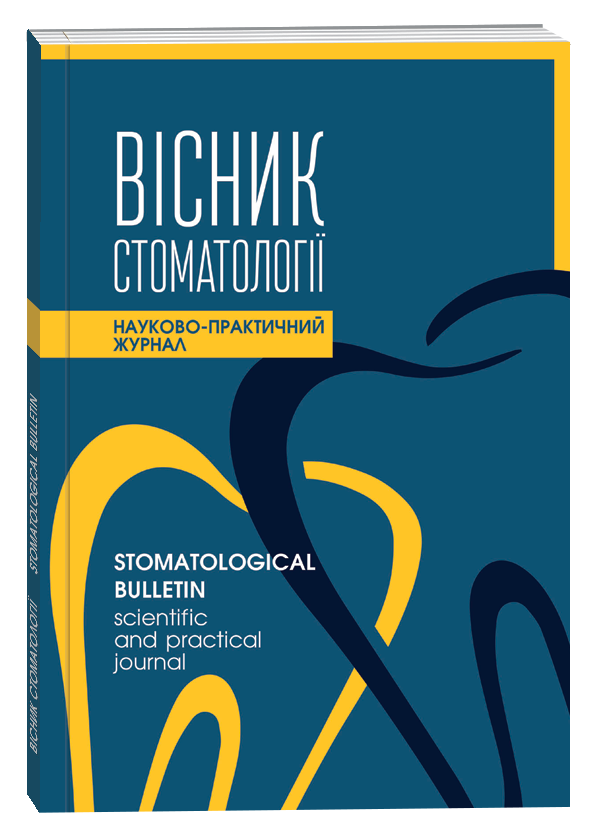RESULTS OF CLINICAL AND INSTRUMENTAL STUDY OF DIGITAL OCCLUSION INDICES DURING REGISTRATION OF INTERMAXILLARY INTERCUSPAL POSITION IN PATIENTS WITH BILATERAL DEFECTS AND INTACT DENTITIONS
DOI:
https://doi.org/10.35220/2078-8916-2021-40-2.8Keywords:
registration material, tubercle-fossa contact of teeth and maximum intercuspidation, defects of dentitions of insignificant length, clinical and instrumental diagnostics of occlusion, methods of digital analysis of occlusion by means of T-Scan® III (“Tekscan”, USA)Abstract
Purpose of the study. Performance of the comparative clinical and instrumental analysis of ICP occlusal relationships registration results in groups of patients with intact dentitions and bilateral defects of dentitions. Research methods. Examination of 10 patients of both sexes aged 24 to 51 years was conducted. All examined patients were divided into the treatment and control groups. The first treatment group of the study included 5 patients with class A2 bilateral defects of dentitions of the DFS according to the Eichner classification. The control group consisted of 5 patients with intact dentitions. Conclusions. The interval of dental occlusion between the ICP and MIC positions, or delta (Δ), which can be determined using Tekscan III digital technology, demonstrates spatiotemporal indices of redistribution of intermaxillary relationships. Their values in patients with partial loss of teeth are of particular interest. With the use of Futar D registration material, clinical and instrumental analysis of digital indices of the transition from ICP to MIC allowed the establishment of the same duration time of dental occlusion and increase in the length of the occlusal trajectory by 1,05, a significant change in proportional participation of the sides of dentitions (p<0,05) in patients of the treatment group compared to the control group. With the use of Consiflex registration material, clinical and instrumental analysis of digital indices of the transition from ICP to MIC allowed the establishment of the extension of time duration of dental occlusion by 1,03, increase in the length of the occlusal trajectory by 1,20, a significant change in proportional participation of the sides of dentitions (p<0,05) in patients of the treatment group compared to the control group. With the use of Aluwax registration material, clinical and instrumental analysis of digital indices of the transition from ICP to MIC allowed the establishment of the extension of time duration of dental occlusion by 1,30, increase in the length of the occlusal trajectory by 1,50, a significant change in proportional participation of the sides of dentitions (p<0,05) in patients of the treatment group compared to the control group.
References
Неспрядько В.П., Клітинський Ю.В., Прощенко А.М. Застосування тимчасових проте- зів у пацієнтів з м’язево-суглобовими функціональ- ними розладами зубощелепно-лицевої ділянки в якості діагностично-лікувальних апаратів. Науковий вісник Національного медичного університету імені О.О. Богомольця. 2006. № 2. С. 98–101.
Craddock H.L., Youngson C.C. A study of the incidence of overeruption and occlusal interferences in unopposed posterior teeth. British Dental Journal. 2004. Vol. 196. № 6. P. 341–348.
Creugers N.H., van’t Spijker A. Tooth wear and occlusion: friends or foes? The International Journal of Prosthodontics. 2007. Vol. 20. № 4. P. 348–350.
Deas D.E., Mealey B.L. Is there an association between occlusion and periodontal destruction?: Only in limited circumstances does occlusal force contribute to periodontal disease progression. Journal of the American Dental Association. 2006. Vol. 137. № 10. P. 1381–1389.
Harrel S.K., Nunn M.E., Hallmon W.W. Is there an association between occlusion and periodontal destruction?: Yes – occlusal forces can contribute to periodontal destruction. Journal of the American Dental Association. 2006. Vol. 137. № 10. P. 1380–1392.
Applied occlusion / R. Wassell et al. London : Quintessence, 2008. 166 p.
Nelson S.J., Ash M.M.Jr. Wheeler’s dental anatomy, physiology, and occlusion. 9th ed. St. Louis, Mo. : Saunders/Elsevier, 2010. xvi, 346 p.
Неспрядько В.П., Мороз Ю.Ю. Зміни зубоще- лепного апарату, які виникають внаслідок оклюзій них порушень у період адаптації пацієнтів до незнім- них зубних протезів (огляд літератури). Буковинський медичний вісник. 2017. Т. 21. № 3. С. 146–153.
Advanced operative dentistry: a practical approach / ed. by D. Ricketts, D. Bartlett. Edinburgh ; New York : Elsevier, 2011. xi, 264 p.
Afrashtehfar K.I., Qadeer S. Computerized occlusal analysis as an alternative occlusal indicator. Cranio. 2016. Vol. 34. № 1. P. 52–57.








